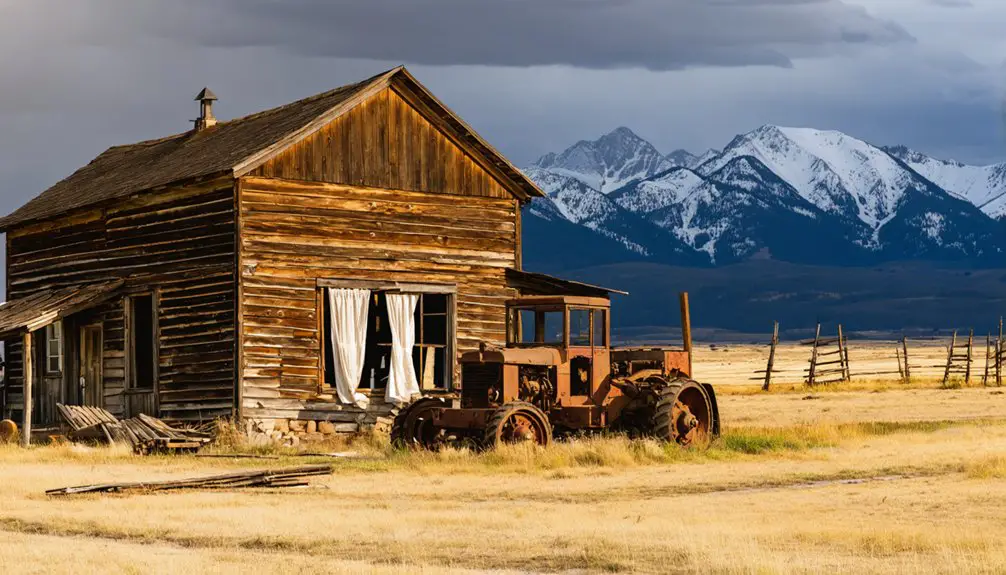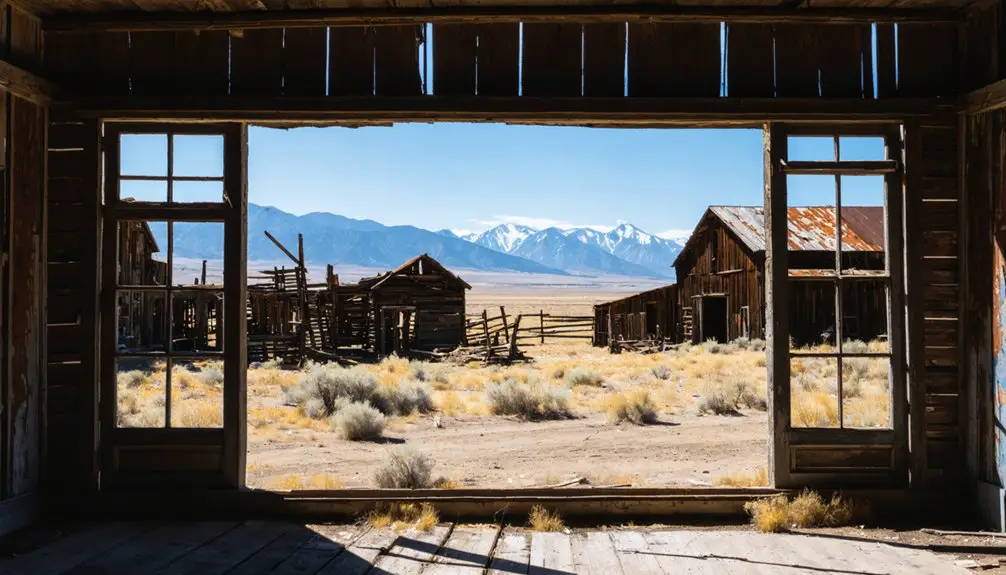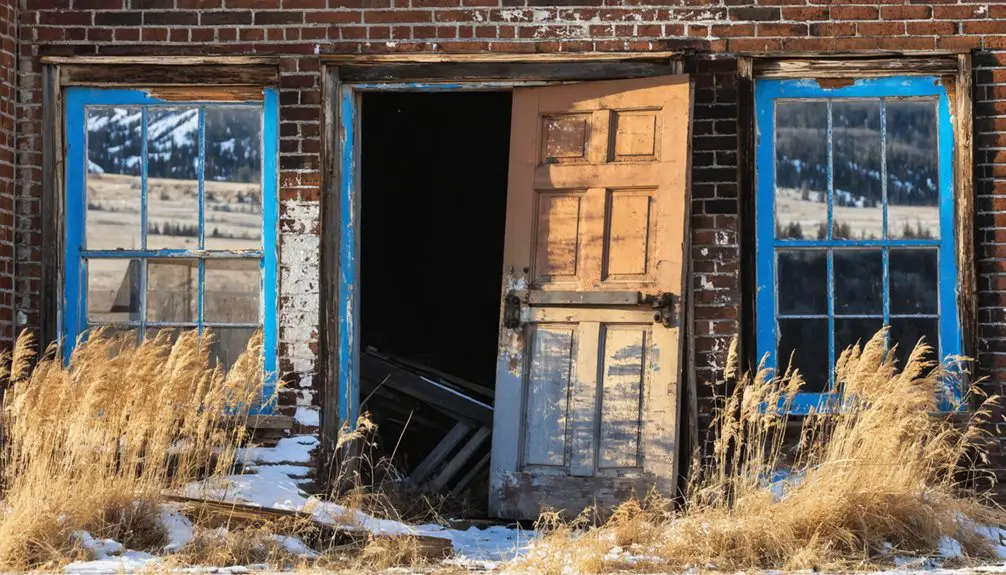You’ll find Vananda’s haunting remains along Montana’s southeastern prairie, where this former railroad town sprang up in 1908. The settlement quickly established key buildings, including a two-story brick schoolhouse and state bank, serving ambitious dryland wheat farmers. Listed on the National Register of Historic Places in 1990, Vananda’s preserved structures tell stories of early 20th-century life, harsh environmental challenges, and the resilient spirit of homesteading communities.
Key Takeaways
- Vananda was established in 1908 as a railroad water stop and transformed into a homestead settlement before becoming abandoned.
- The town features a preserved two-story brick schoolhouse from 1920 and relocated bank building, now key attractions for ghost town visitors.
- Economic decline struck in the 1920s due to severe drought conditions and falling commodity prices, leading to the town’s abandonment.
- Notable architectural remnants include Classical Revival and Bungalow-style structures listed on the National Register of Historic Places.
- The site contains scattered railroad ruins, oil reclamation equipment, and historic debris, marking different phases of the town’s economic history.
From Railroad Stop to Prairie Settlement
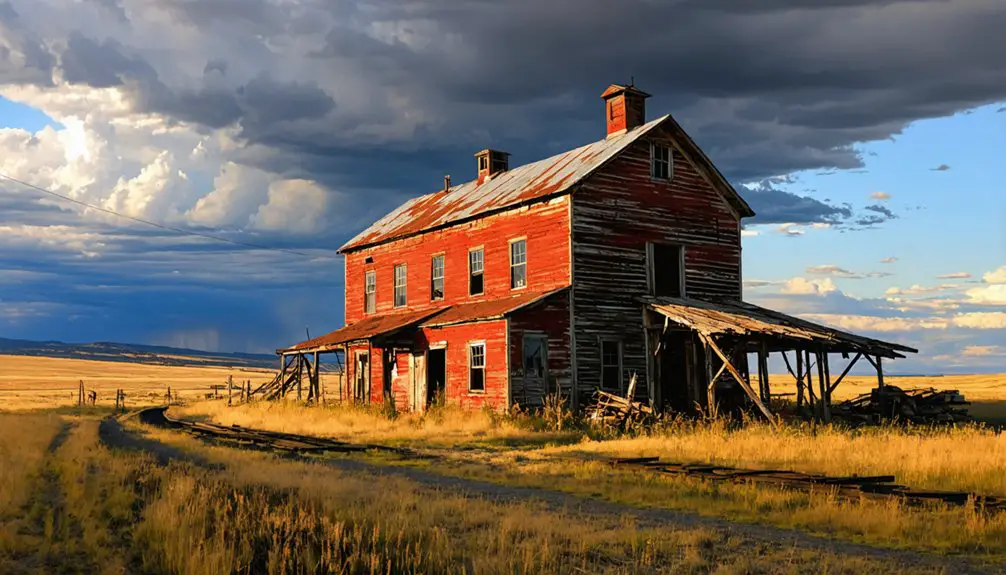
When the Chicago, Milwaukee, St. Paul and Pacific Railroad began construction through Montana in 1908, they established Vananda as an essential water stop in the arid plains.
You’ll find that this strategic location between the Yellowstone and Musselshell River valleys quickly attracted homesteaders, drawn by the railroad’s aggressive advertising campaigns promising opportunity in the Montana territory.
The railroad impact transformed the empty prairie into a budding settlement, with newcomers arriving alongside the construction crews.
As the community grew, Vananda developed into more than just a depot – you’d have seen the emergence of a two-story school, state bank, and modest homes in Classical Revival and Bungalow styles.
While the railroad’s presence initially spurred development, the town’s 32-acre footprint remained relatively modest, reflecting the challenges of sustaining life on the drought-prone land.
The Rise and Fall of a Banking Hub
As Vananda sought to establish itself as a regional financial center, the construction of Vananda State Bank in 1917 marked an ambitious step forward for the young settlement. The brick building, crafted by Louis Wahl, stood prominently as the town’s only brick commercial structure, offering essential banking services to homesteaders and railroad workers.
You’d have found a bustling financial hub during the early 1920s, supporting local enterprises like the Vananda Mercantile Company.
However, the bank’s prosperity wouldn’t last. Harsh economic challenges, including severe drought and plummeting commodity prices, devastated the farming community. By 1923, the bank closed its doors, later serving as the town’s post office until 1959.
Today, you’ll find the historic building in Forsyth, where it stands as a preserved reminder of Vananda’s brief but significant banking era.
Life in Early 20th Century Vananda
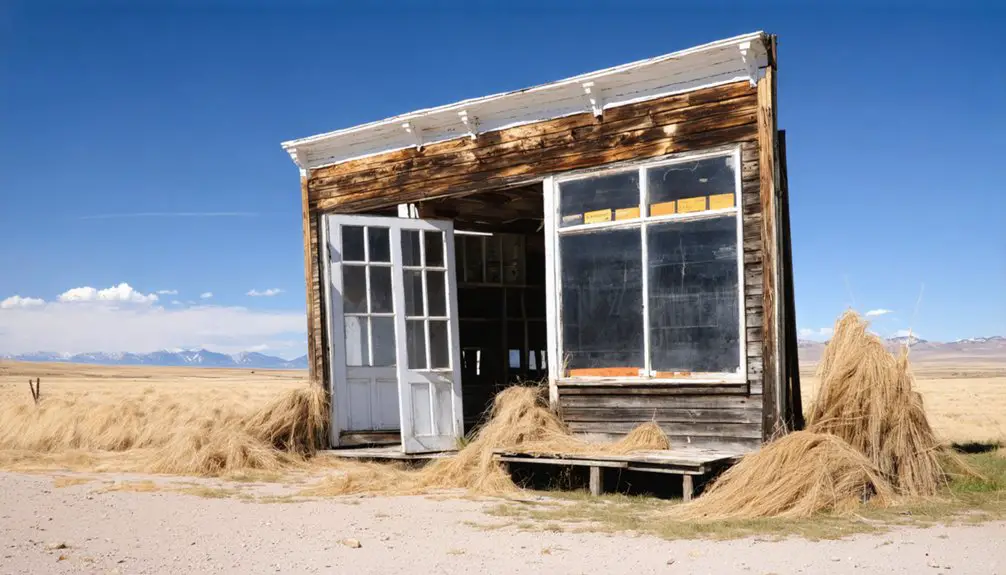
Life in early 20th century Vananda centered around ambitious 320-acre dryland wheat farms, twice the size of typical homesteads elsewhere.
Determined farmers carved out massive 320-acre wheat operations in Vananda, dwarfing the standard homestead size of America’s frontier settlements.
You’d find settlers breaking tough prairie sod while battling harsh growing conditions and brief seasons in their quest for agricultural success.
The town’s social fabric revolved around key institutions you’d expect in a frontier community. You could do your banking at the local branch that opened in 1917, send your children to the impressive two-story schoolhouse built in the early 1920s, and conduct business along the Milwaukee Railroad line.
The school’s Craftsman and Classical Revival architecture showcased the community’s aspirations, serving as both an educational center and social hub for local families.
Despite the challenges, Vananda’s residents built a determined community focused on mutual support and progress.
Educational Legacy: The Iconic Schoolhouse
Standing proudly atop a hill in 1920, Vananda’s impressive brick schoolhouse emerged as the community’s most ambitious architectural achievement. Built by renowned Forsyth contractor Louis Wahl, this Classical Revival masterpiece could accommodate up to 100 students, reflecting the town’s optimistic vision for growth.
You’ll find that the two- or three-story structure wasn’t just about educational traditions – it served as the heart of community gatherings, bringing homesteaders together during Vananda’s peak years.
While most rural schools were simple wooden structures, this brick edifice symbolized permanence and prosperity. Even after the agricultural bust of the 1920s and the town’s eventual decline, the schoolhouse remained a tribute to frontier determination.
Today, it stands as one of Vananda’s few surviving structures, a silent guardian of Montana’s homesteading dreams.
Architectural Treasures of the Historic District
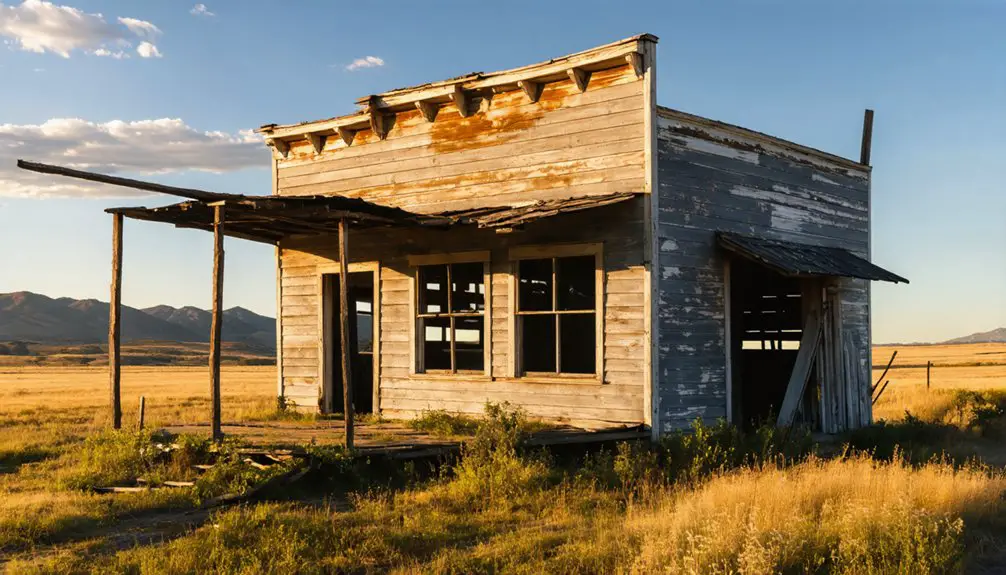
When Vananda reached its peak in the early 1920s, the town’s historic district showcased an impressive collection of architectural styles that reflected its railroad-driven prosperity.
You’ll find the grandest example in the two-story brick schoolhouse, built to serve up to 100 students. The Classical Revival-style Vananda State Bank, designed by L.W. Wahl, stood proudly with its yellow and red brick facade.
Beyond these institutional landmarks, you’ll discover homes like the Berg and Jacobsen residences, which display both simple homesteader and Craftsman influences.
While many structures have succumbed to time since the railroad’s abandonment in 1980, preservation efforts through the National Register of Historic Places in 1990 have helped protect key buildings.
The bank’s relocation to Forsyth guarantees this piece of Montana’s homesteading heritage endures.
Vananda’s Battle Against Harsh Elements
If you’d visited Vananda during its early homesteading days, you’d have witnessed settlers grappling with the harsh realities of Montana’s semi-arid climate, where limited rainfall and extreme temperature swings made farming nearly impossible.
The community’s struggle against persistent drought conditions was evident in their reliance on a small railroad reservoir, which proved insufficient for sustaining both steam locomotives and agricultural needs.
Despite the homesteaders’ determination to establish roots in this remote prairie town after 1907, the unforgiving environmental conditions ultimately contributed to Vananda’s population decline by the 1920s.
Survival Against Prairie Drought
Throughout its brief existence, Vananda faced a relentless battle against the harsh realities of Montana’s prairie environment, where water scarcity and poor soil conditions ultimately proved insurmountable.
You’ll find evidence of the community’s struggle for water conservation in the railroad’s small reservoir, which served steam locomotives but couldn’t sustain the broader agricultural needs of homesteaders. Despite attempts at drought resilience, the harsh climate and infertile soil made farming nearly impossible on standard 160-acre plots.
While the railroad’s presence initially provided hope, maintaining water infrastructure became increasingly difficult. When drought periods intensified and the Great Depression hit, these environmental challenges overwhelmed the town’s resources.
Even the construction of substantial buildings, like the two-story schoolhouse, couldn’t overcome nature’s unforgiving grip on Vananda’s future.
Homesteaders Face Nature’s Fury
Life in Vananda demanded extraordinary resilience as homesteaders battled nature’s most brutal elements year-round.
You’d face bone-chilling winters with deadly blizzards that could trap you for days, followed by treacherous spring floods that’d wash away your hard work.
Summer brought scorching heat waves pushing past 100°F, while relentless prairie winds stirred up dust storms that choked both crops and lungs.
Weather resilience meant adapting to nature’s constant threats. You’d build windbreaks, reinforce structures, and rely on community cooperation to survive.
When storms isolated families, neighbors helped neighbors. When floods threatened homes, settlers worked together.
Railway disruptions and failed postal services tested your self-reliance, but Vananda’s homesteaders proved their grit by facing each challenge with determination and mutual support.
Modern-Day Remnants and Historical Recognition
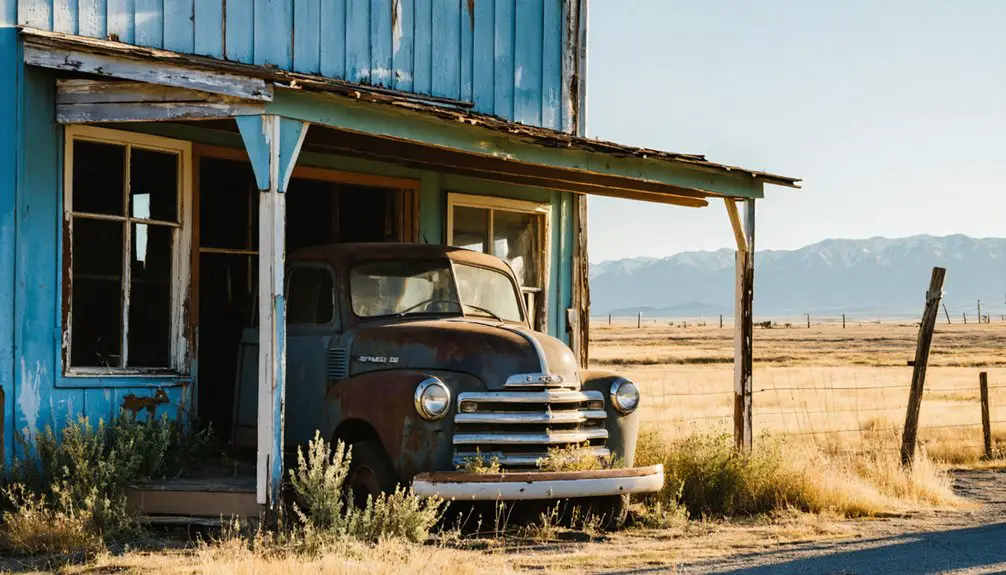
While many Montana ghost towns have vanished entirely, Vananda’s remaining structures offer a compelling glimpse into early 20th-century frontier life.
You’ll find preservation challenges at every turn, yet the site’s inclusion on the National Register of Historic Places in 1990 has helped draw ghost town tourism to these remarkable ruins.
- The imposing 1920 brick schoolhouse stands as the town’s centerpiece, though its rotting floors make exploration dangerous
- The Classical Revival bank building survives in nearby Forsyth, relocated from its original location
- Early 1920s bungalows, including the Berg and Jacobsen residences, dot the landscape
- Railroad infrastructure remains only in scattered ruins since its 1980 abandonment
- Oil reclamation equipment from later years mingles with historic debris throughout the site
Frequently Asked Questions
What Was the Population of Vananda at Its Peak?
You’ll find the peak population reached about 200 residents before experiencing rapid population decline. This historically significant homesteading community thrived briefly during favorable agricultural conditions until drought struck the region.
Are There Any Current Residents Living in Vananda?
You won’t find any current inhabitants in this true ghost town – while you might hear ghost stories about its abandoned buildings, the last residents left decades ago as the community completely dissolved.
Can Visitors Legally Explore the Remaining Buildings in Vananda?
You can’t legally explore buildings without property owner permission. Ghost town regulations require authorization, and building safety concerns make unauthorized entry risky and potentially illegal due to trespassing laws.
What Native American Tribes Originally Inhabited the Vananda Area?
You’ll find rich cultural heritage from Native tribes who once roamed these plains: primarily the Crow, while Lakota (Sioux), Cheyenne, and Blackfeet peoples also traversed and hunted this ancestral land.
Has Any Paranormal Activity Been Reported in Abandoned Vananda Buildings?
You won’t find specific ghost sightings documented in Vananda’s buildings, though similar Montana ghost towns report haunted history patterns like unexplained voices, footsteps, and apparitions in their abandoned structures.
References
- https://en.wikipedia.org/wiki/Vananda
- https://my1035.com/ixp/628/p/abandoned-montana-school/
- https://www.hmdb.org/m.asp?m=164685
- http://lostandfoundmontana.com/towns/vananda.html
- https://www.youtube.com/watch?v=filDIvUeO5A
- https://npgallery.nps.gov/GetAsset/0b3e5b14-1f1a-4044-99d5-f203cb3fd631
- https://mths.mt.gov/education/Textbook/Chapter9/chapter9.pdf
- http://www.lostandfoundmontana.com/towns/vananda.html
- http://coopdwaycorner.blogspot.com/2021/03/vananda-montana-1916.html
- https://montanahistoriclandscape.com/tag/vananda-montana/
